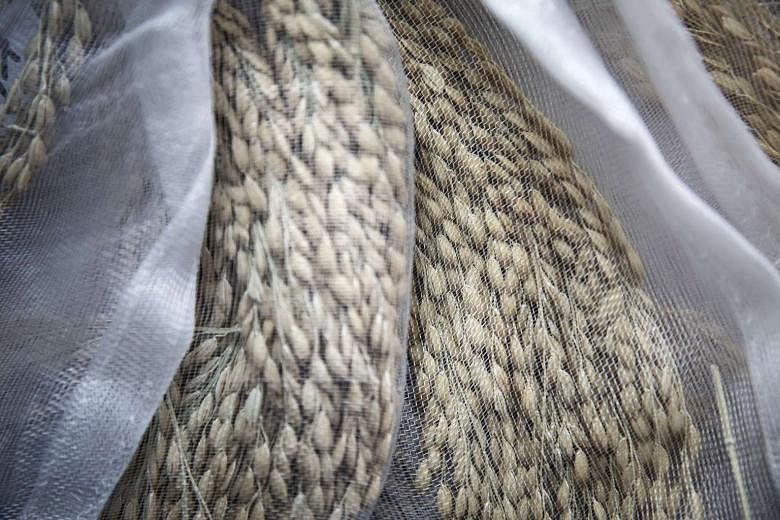BEIJING (BLOOMBERG) - With a stack of small, brown envelopes in hand, Li Jianyue trudges through a rice field in southern China to gather grain specimens she hopes might one day fight diabetes.
The obesity-linked disease is on a tear in China, and rice - the country's favourite staple - is showing up in studies as an important contributor.
The black kernels that Li pinches off mature stalks with her fingers and drops into paper sachets have been bred to avoid causing the high spikes in blood sugar when eaten, which can eventually lead to type-2 diabetes.
China tops the world in the number of adults living with diabetes: 109.6 million as of 2015. Another 40 million could join the ranks by 2040 unless preventative steps are taken.
Refined white rice is seen as an obvious target because the majority of the nation's 1.4 billion people consume it at least once a day, and eating it has a similar effect on blood-sugar levels as gorging on white bread.
"The number of people with diabetes is surging," said Li, a professor of life and environment sciences at Shanghai Normal University, treading between muddy rows of rice in green rubber boots.
Still, healthier rice alone won't tackle the problem - it has to taste good too, she said. "So, we're also trying to improve the texture."
The rice experiments Li is working on - under a giant bird net at a plant-breeding site about 20 kilometres from Sanya city, on the southern tip of Hainan island - are part of an international effort to improve the nutritional value of rice.
The Bill & Melinda Gates Foundation, for example, is working with rice researchers in the Philippines and Bangladesh on rice enriched with vitamin A to tackle blindness.
Gut Health Australia's Commonwealth Scientific and Industrial Research Organisation (CSIRO), is developing rice with more fiber so that it's broken down in the lower digestive tract, where it can aid gut health and avoid the glucose-surge that can weaken the body's response to insulin and eventually lead to type-2 diabetes.
A separate programme underway with the Chinese Academy of Sciences is seeking to pack rice with more vitamin B and E, iron, and zinc.
"Middle-class Chinese are now very focused on nutrition," said Phil Larkin, a chief research scientist with the CSIRO in Canberra. "The rate of increase in type-2 diabetes in China is very frightening."
A study released in 2013 estimated that China had 114 million people living with diabetes, or 21.6 million million more than a study three years earlier.
BLACK RICE
Li's experimental rice has a larger germ - the embryonic part of the kernel - than normal rice, she explains. That feature gives it more protein and less carbohydrate, which is converted into glucose during digestion. Her current work involves creating hybrids that combine that property with the taste and texture of the rice varieties popular on China's populous eastern seaboard.
Black rice from her lab grown on a 1-hectare plot last year was sold to two local companies. Shanghai Microwells Biotechnology Co. removed the hull and blended it unpolished with white rice in a 20 per cent blend.
General Manager He Jianhui said it was a potentially risky move since most Chinese prefer eating white rice and believe that unpolished rough rice is inferior.
"But, now that more Chinese are seeking a healthy diet, we hope the unpolished rice can help people with the potential to develop diabetes, and that by improving their diet, they can avoid turning to doctors for medicine," He said.
Refined white rice - even varieties bred to have less of a detrimental effect on blood-sugar - is still a nutrient-poor food, said Sun Qi, an assistant professor at Harvard University's T.H. Chan School of Public Health in Boston.
Meanwhile, whole grains, including brown rice, are rich in cereal fiber, minerals, vitamins, and beneficial phytochemicals.
RICE YIELDS
Hybrid varieties with increased vigor and disease-resistance have helped China achieve some of the world's highest rice yields among major producers and remain largely self-sufficient in the cereal, even as consumption advanced 13 per cent over the past decade driven by population growth.
Until recently, nutritional and processing quality had been overlooked in striving for yield improvement, said Zhongyi Li, a plant molecular biologist with the CSIRO's in Canberra.
Annual per-capita consumption slipped to 104.8 kilograms in China last year, from a peak of 109.7 kilograms in 1997, as diets changed and improved food transportation gave consumers more choice. The nation's wheat-based bakery industry expanded about 10 percent last year.
Making rice more nutritious and less likely to accumulate heavy metals, like cadmium, may help reverse the decline in per-capita consumption, and boost prices. Japonica rice futures on Zhengzhou Commodity Exchange have dropped 8 percent this year, while long-grain non-glutinous rice has advanced 2.7 per cent.
GLYCEMIC IMPACT
In the Philippines, the International Rice Research Institute (IRRI) has identified the genetic basis of a component of starch that may be used to counter the cereal's glycemic impact - or propensity to spike blood-sugar, said Nese Sreenivasulu, head of the institute's grain quality and nutrition centre.
IRRI found in 2012 that the glycemic index (GI) of rice ranges from 48 to 92 across more than 200 varieties from around the world.
The sugars of low-GI food are absorbed more slowly, resulting in a gradual and sustained release of glucose in the blood, reducing the need for a surge of insulin that can eventually lead to insulin-resistance and diabetes.
"As of today, more than 430 million cases of type-2 diabetes occur worldwide and the problem is severe in developing countries like China and India," Sreenivasulu said. "Many modern varieties have a high to intermediate glycemic index, hence breeding for low-GI is an important trait."

